Early Adolescence: Biological, Psychological, and Social Developments
VerifiedAdded on 2022/11/23
|8
|1677
|458
Report
AI Summary
This report provides a detailed overview of the changes that occur during early adolescence, specifically focusing on girls aged 9 to 13. It begins by defining early adolescence (also known as preadolescence) and then delves into the biological changes, such as breast development, body hair growth, and the onset of menstruation (menarche). The report also explores the psychological changes, including mood swings and the development of emotional bonds, as well as cognitive changes, such as the shift towards rationalized thinking. Social issues, such as concerns about appearance and peer relationships, are also discussed. The report concludes by emphasizing the importance of parental support during this crucial developmental stage. The report references multiple sources and is formatted in APA style.
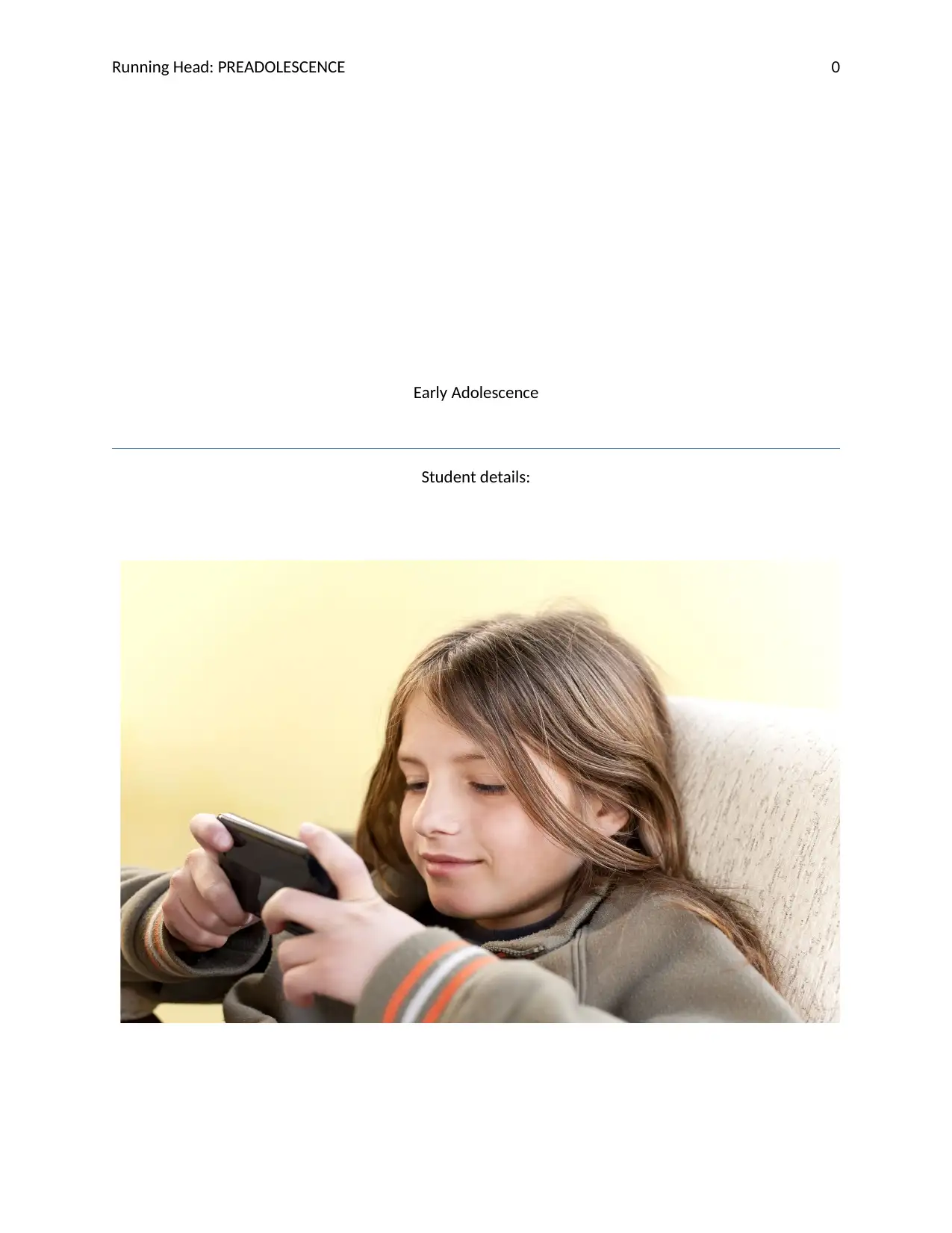
Running Head: PREADOLESCENCE 0
Early Adolescence
Student details:
Early Adolescence
Student details:
Paraphrase This Document
Need a fresh take? Get an instant paraphrase of this document with our AI Paraphraser
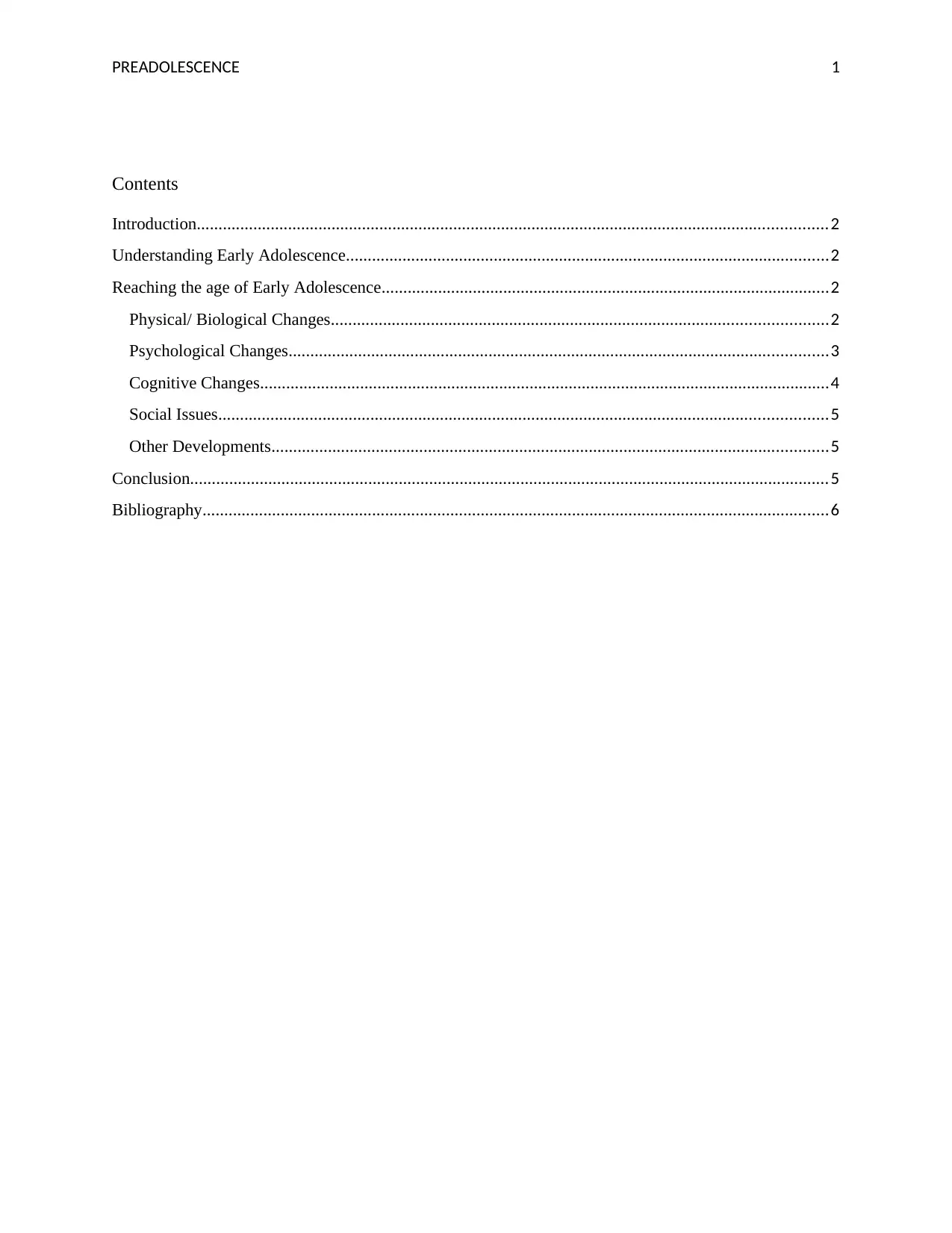
PREADOLESCENCE 1
Contents
Introduction.................................................................................................................................................2
Understanding Early Adolescence...............................................................................................................2
Reaching the age of Early Adolescence.......................................................................................................2
Physical/ Biological Changes..................................................................................................................2
Psychological Changes............................................................................................................................3
Cognitive Changes...................................................................................................................................4
Social Issues............................................................................................................................................5
Other Developments................................................................................................................................5
Conclusion...................................................................................................................................................5
Bibliography................................................................................................................................................6
Contents
Introduction.................................................................................................................................................2
Understanding Early Adolescence...............................................................................................................2
Reaching the age of Early Adolescence.......................................................................................................2
Physical/ Biological Changes..................................................................................................................2
Psychological Changes............................................................................................................................3
Cognitive Changes...................................................................................................................................4
Social Issues............................................................................................................................................5
Other Developments................................................................................................................................5
Conclusion...................................................................................................................................................5
Bibliography................................................................................................................................................6
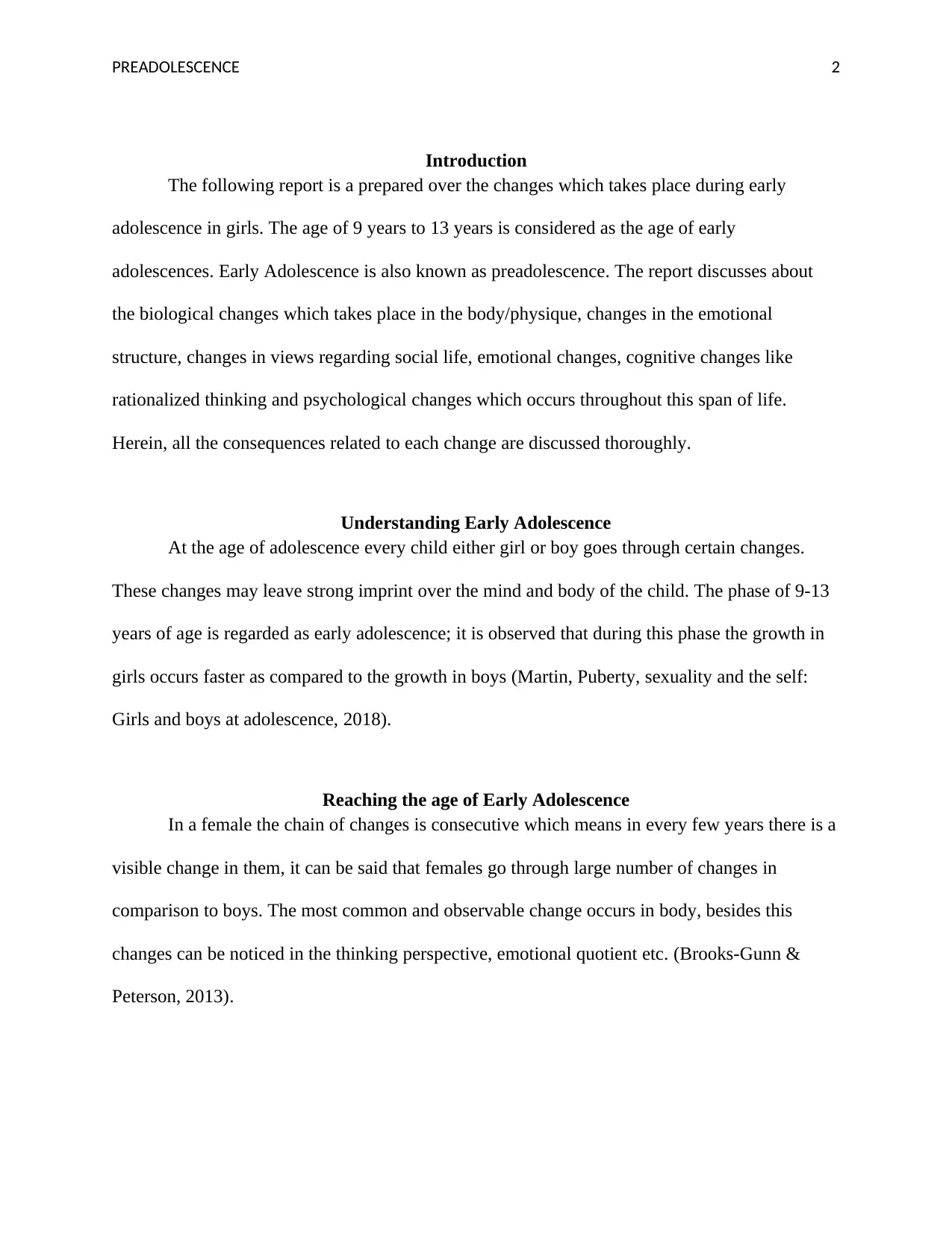
PREADOLESCENCE 2
Introduction
The following report is a prepared over the changes which takes place during early
adolescence in girls. The age of 9 years to 13 years is considered as the age of early
adolescences. Early Adolescence is also known as preadolescence. The report discusses about
the biological changes which takes place in the body/physique, changes in the emotional
structure, changes in views regarding social life, emotional changes, cognitive changes like
rationalized thinking and psychological changes which occurs throughout this span of life.
Herein, all the consequences related to each change are discussed thoroughly.
Understanding Early Adolescence
At the age of adolescence every child either girl or boy goes through certain changes.
These changes may leave strong imprint over the mind and body of the child. The phase of 9-13
years of age is regarded as early adolescence; it is observed that during this phase the growth in
girls occurs faster as compared to the growth in boys (Martin, Puberty, sexuality and the self:
Girls and boys at adolescence, 2018).
Reaching the age of Early Adolescence
In a female the chain of changes is consecutive which means in every few years there is a
visible change in them, it can be said that females go through large number of changes in
comparison to boys. The most common and observable change occurs in body, besides this
changes can be noticed in the thinking perspective, emotional quotient etc. (Brooks-Gunn &
Peterson, 2013).
Introduction
The following report is a prepared over the changes which takes place during early
adolescence in girls. The age of 9 years to 13 years is considered as the age of early
adolescences. Early Adolescence is also known as preadolescence. The report discusses about
the biological changes which takes place in the body/physique, changes in the emotional
structure, changes in views regarding social life, emotional changes, cognitive changes like
rationalized thinking and psychological changes which occurs throughout this span of life.
Herein, all the consequences related to each change are discussed thoroughly.
Understanding Early Adolescence
At the age of adolescence every child either girl or boy goes through certain changes.
These changes may leave strong imprint over the mind and body of the child. The phase of 9-13
years of age is regarded as early adolescence; it is observed that during this phase the growth in
girls occurs faster as compared to the growth in boys (Martin, Puberty, sexuality and the self:
Girls and boys at adolescence, 2018).
Reaching the age of Early Adolescence
In a female the chain of changes is consecutive which means in every few years there is a
visible change in them, it can be said that females go through large number of changes in
comparison to boys. The most common and observable change occurs in body, besides this
changes can be noticed in the thinking perspective, emotional quotient etc. (Brooks-Gunn &
Peterson, 2013).
⊘ This is a preview!⊘
Do you want full access?
Subscribe today to unlock all pages.

Trusted by 1+ million students worldwide
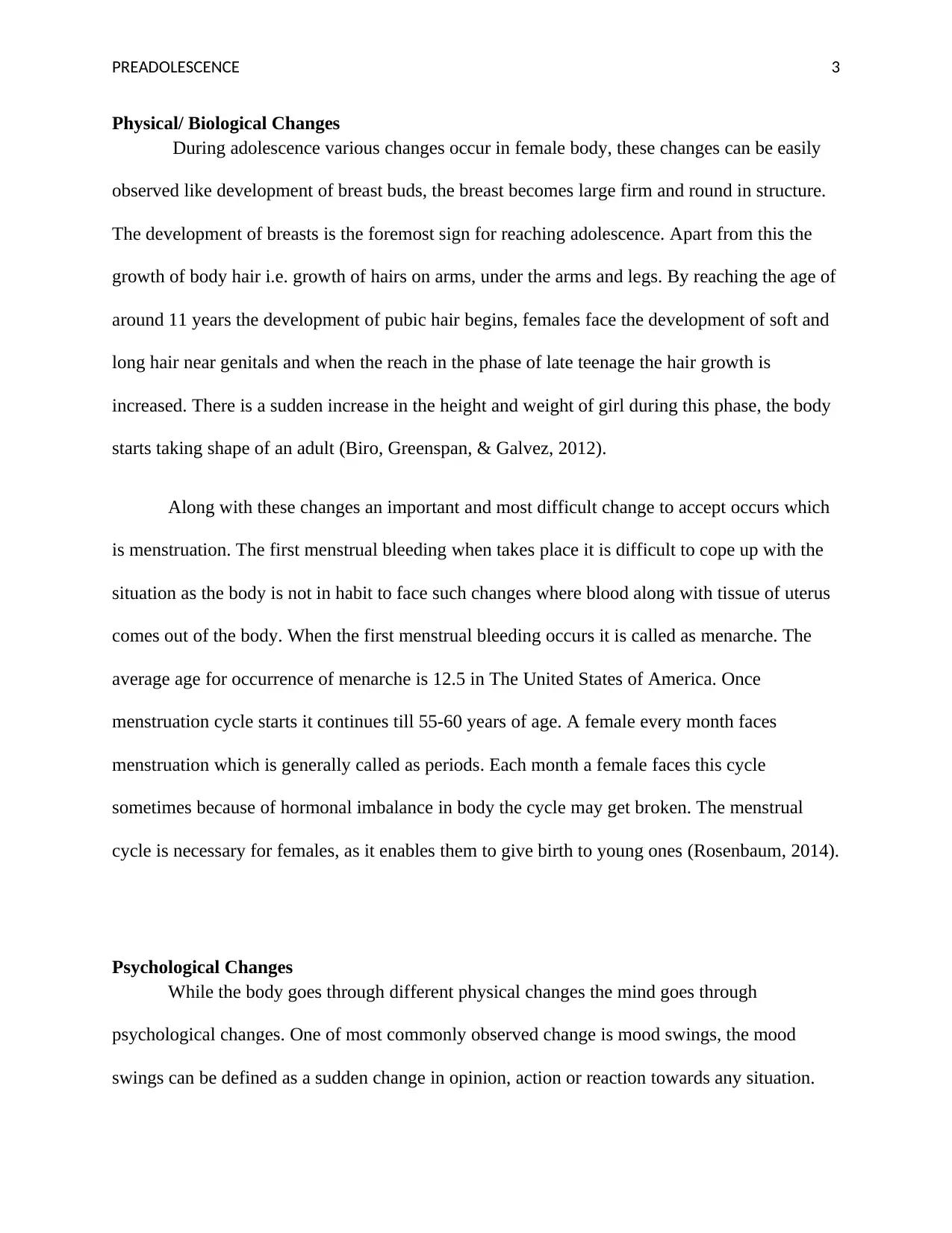
PREADOLESCENCE 3
Physical/ Biological Changes
During adolescence various changes occur in female body, these changes can be easily
observed like development of breast buds, the breast becomes large firm and round in structure.
The development of breasts is the foremost sign for reaching adolescence. Apart from this the
growth of body hair i.e. growth of hairs on arms, under the arms and legs. By reaching the age of
around 11 years the development of pubic hair begins, females face the development of soft and
long hair near genitals and when the reach in the phase of late teenage the hair growth is
increased. There is a sudden increase in the height and weight of girl during this phase, the body
starts taking shape of an adult (Biro, Greenspan, & Galvez, 2012).
Along with these changes an important and most difficult change to accept occurs which
is menstruation. The first menstrual bleeding when takes place it is difficult to cope up with the
situation as the body is not in habit to face such changes where blood along with tissue of uterus
comes out of the body. When the first menstrual bleeding occurs it is called as menarche. The
average age for occurrence of menarche is 12.5 in The United States of America. Once
menstruation cycle starts it continues till 55-60 years of age. A female every month faces
menstruation which is generally called as periods. Each month a female faces this cycle
sometimes because of hormonal imbalance in body the cycle may get broken. The menstrual
cycle is necessary for females, as it enables them to give birth to young ones (Rosenbaum, 2014).
Psychological Changes
While the body goes through different physical changes the mind goes through
psychological changes. One of most commonly observed change is mood swings, the mood
swings can be defined as a sudden change in opinion, action or reaction towards any situation.
Physical/ Biological Changes
During adolescence various changes occur in female body, these changes can be easily
observed like development of breast buds, the breast becomes large firm and round in structure.
The development of breasts is the foremost sign for reaching adolescence. Apart from this the
growth of body hair i.e. growth of hairs on arms, under the arms and legs. By reaching the age of
around 11 years the development of pubic hair begins, females face the development of soft and
long hair near genitals and when the reach in the phase of late teenage the hair growth is
increased. There is a sudden increase in the height and weight of girl during this phase, the body
starts taking shape of an adult (Biro, Greenspan, & Galvez, 2012).
Along with these changes an important and most difficult change to accept occurs which
is menstruation. The first menstrual bleeding when takes place it is difficult to cope up with the
situation as the body is not in habit to face such changes where blood along with tissue of uterus
comes out of the body. When the first menstrual bleeding occurs it is called as menarche. The
average age for occurrence of menarche is 12.5 in The United States of America. Once
menstruation cycle starts it continues till 55-60 years of age. A female every month faces
menstruation which is generally called as periods. Each month a female faces this cycle
sometimes because of hormonal imbalance in body the cycle may get broken. The menstrual
cycle is necessary for females, as it enables them to give birth to young ones (Rosenbaum, 2014).
Psychological Changes
While the body goes through different physical changes the mind goes through
psychological changes. One of most commonly observed change is mood swings, the mood
swings can be defined as a sudden change in opinion, action or reaction towards any situation.
Paraphrase This Document
Need a fresh take? Get an instant paraphrase of this document with our AI Paraphraser
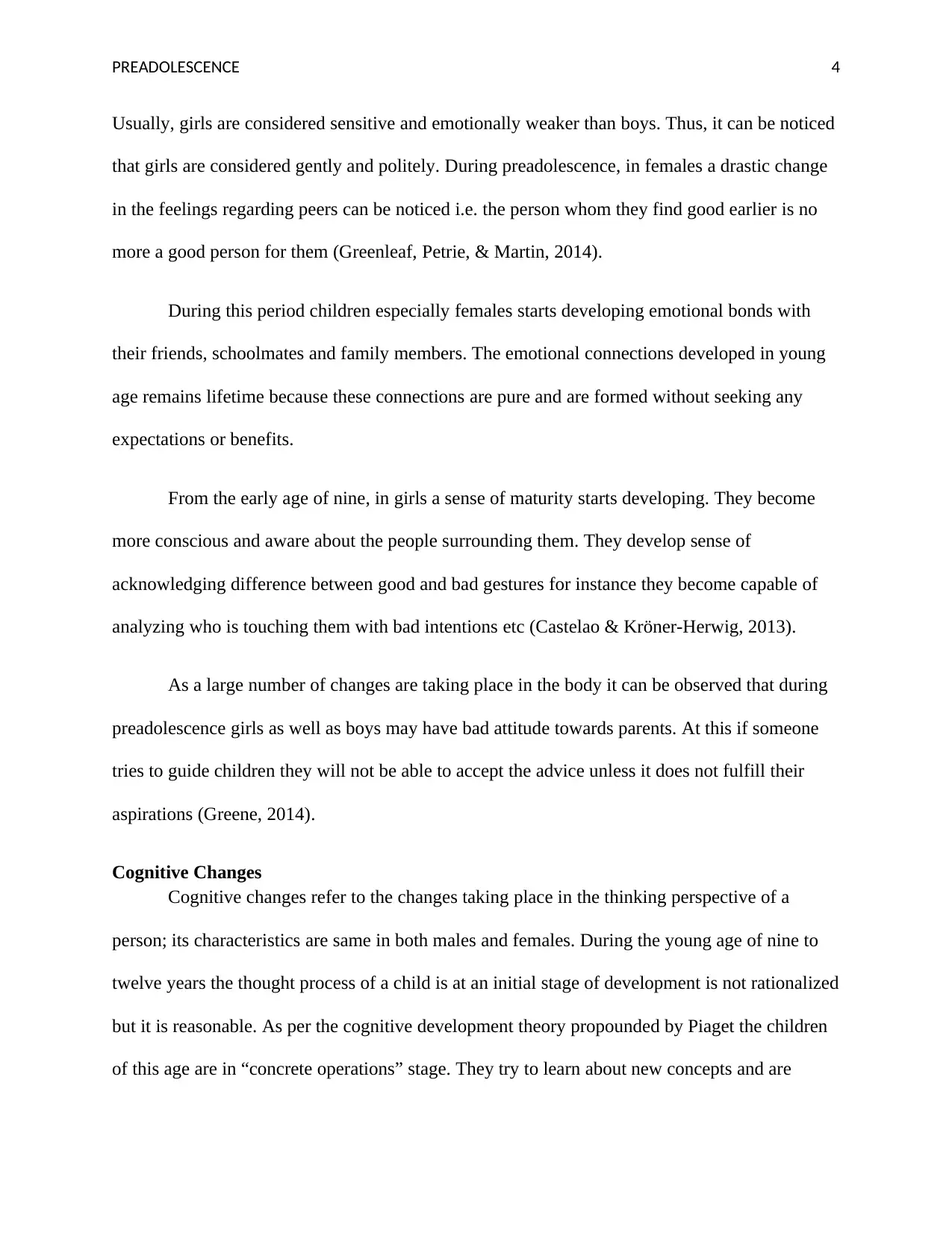
PREADOLESCENCE 4
Usually, girls are considered sensitive and emotionally weaker than boys. Thus, it can be noticed
that girls are considered gently and politely. During preadolescence, in females a drastic change
in the feelings regarding peers can be noticed i.e. the person whom they find good earlier is no
more a good person for them (Greenleaf, Petrie, & Martin, 2014).
During this period children especially females starts developing emotional bonds with
their friends, schoolmates and family members. The emotional connections developed in young
age remains lifetime because these connections are pure and are formed without seeking any
expectations or benefits.
From the early age of nine, in girls a sense of maturity starts developing. They become
more conscious and aware about the people surrounding them. They develop sense of
acknowledging difference between good and bad gestures for instance they become capable of
analyzing who is touching them with bad intentions etc (Castelao & Kröner-Herwig, 2013).
As a large number of changes are taking place in the body it can be observed that during
preadolescence girls as well as boys may have bad attitude towards parents. At this if someone
tries to guide children they will not be able to accept the advice unless it does not fulfill their
aspirations (Greene, 2014).
Cognitive Changes
Cognitive changes refer to the changes taking place in the thinking perspective of a
person; its characteristics are same in both males and females. During the young age of nine to
twelve years the thought process of a child is at an initial stage of development is not rationalized
but it is reasonable. As per the cognitive development theory propounded by Piaget the children
of this age are in “concrete operations” stage. They try to learn about new concepts and are
Usually, girls are considered sensitive and emotionally weaker than boys. Thus, it can be noticed
that girls are considered gently and politely. During preadolescence, in females a drastic change
in the feelings regarding peers can be noticed i.e. the person whom they find good earlier is no
more a good person for them (Greenleaf, Petrie, & Martin, 2014).
During this period children especially females starts developing emotional bonds with
their friends, schoolmates and family members. The emotional connections developed in young
age remains lifetime because these connections are pure and are formed without seeking any
expectations or benefits.
From the early age of nine, in girls a sense of maturity starts developing. They become
more conscious and aware about the people surrounding them. They develop sense of
acknowledging difference between good and bad gestures for instance they become capable of
analyzing who is touching them with bad intentions etc (Castelao & Kröner-Herwig, 2013).
As a large number of changes are taking place in the body it can be observed that during
preadolescence girls as well as boys may have bad attitude towards parents. At this if someone
tries to guide children they will not be able to accept the advice unless it does not fulfill their
aspirations (Greene, 2014).
Cognitive Changes
Cognitive changes refer to the changes taking place in the thinking perspective of a
person; its characteristics are same in both males and females. During the young age of nine to
twelve years the thought process of a child is at an initial stage of development is not rationalized
but it is reasonable. As per the cognitive development theory propounded by Piaget the children
of this age are in “concrete operations” stage. They try to learn about new concepts and are
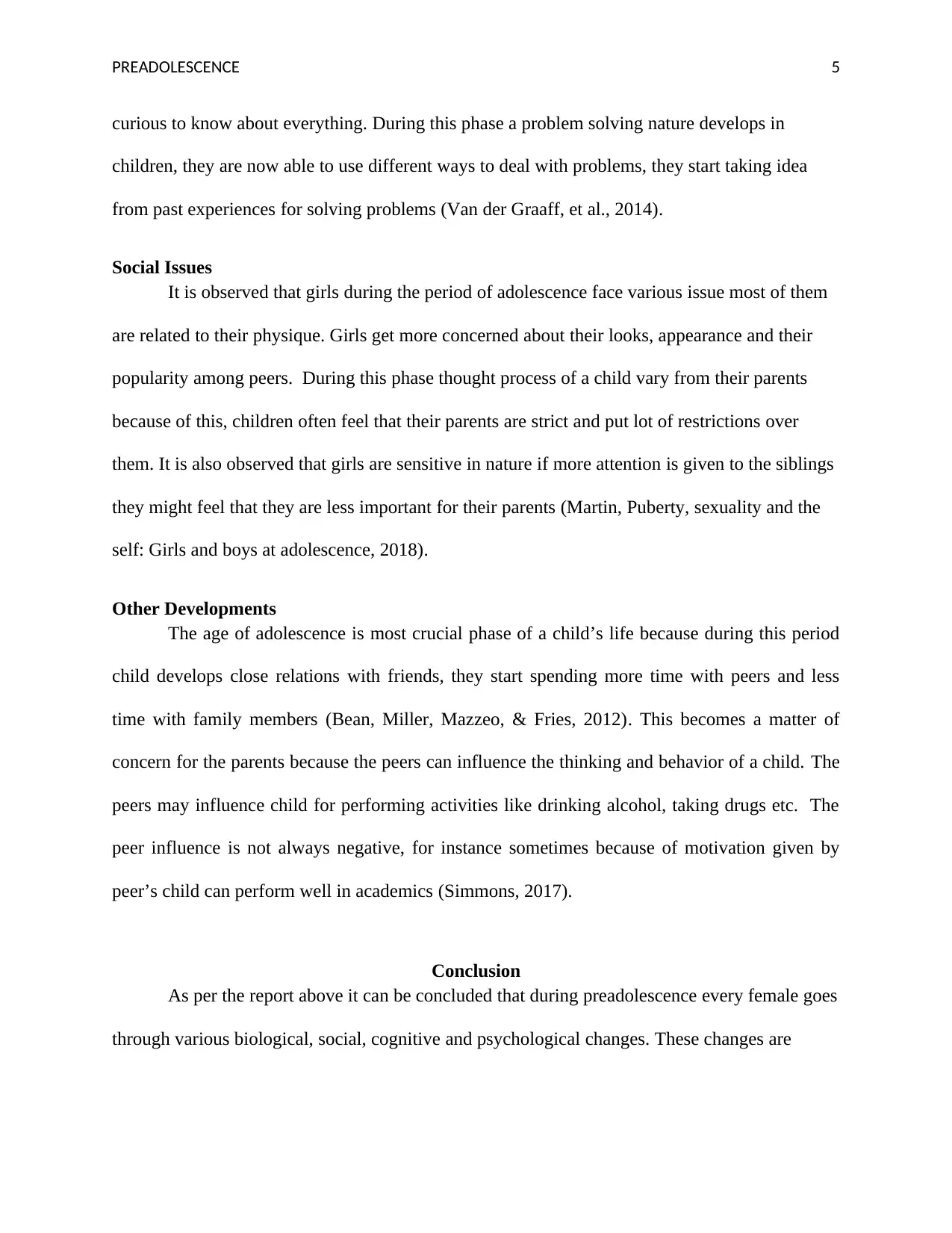
PREADOLESCENCE 5
curious to know about everything. During this phase a problem solving nature develops in
children, they are now able to use different ways to deal with problems, they start taking idea
from past experiences for solving problems (Van der Graaff, et al., 2014).
Social Issues
It is observed that girls during the period of adolescence face various issue most of them
are related to their physique. Girls get more concerned about their looks, appearance and their
popularity among peers. During this phase thought process of a child vary from their parents
because of this, children often feel that their parents are strict and put lot of restrictions over
them. It is also observed that girls are sensitive in nature if more attention is given to the siblings
they might feel that they are less important for their parents (Martin, Puberty, sexuality and the
self: Girls and boys at adolescence, 2018).
Other Developments
The age of adolescence is most crucial phase of a child’s life because during this period
child develops close relations with friends, they start spending more time with peers and less
time with family members (Bean, Miller, Mazzeo, & Fries, 2012). This becomes a matter of
concern for the parents because the peers can influence the thinking and behavior of a child. The
peers may influence child for performing activities like drinking alcohol, taking drugs etc. The
peer influence is not always negative, for instance sometimes because of motivation given by
peer’s child can perform well in academics (Simmons, 2017).
Conclusion
As per the report above it can be concluded that during preadolescence every female goes
through various biological, social, cognitive and psychological changes. These changes are
curious to know about everything. During this phase a problem solving nature develops in
children, they are now able to use different ways to deal with problems, they start taking idea
from past experiences for solving problems (Van der Graaff, et al., 2014).
Social Issues
It is observed that girls during the period of adolescence face various issue most of them
are related to their physique. Girls get more concerned about their looks, appearance and their
popularity among peers. During this phase thought process of a child vary from their parents
because of this, children often feel that their parents are strict and put lot of restrictions over
them. It is also observed that girls are sensitive in nature if more attention is given to the siblings
they might feel that they are less important for their parents (Martin, Puberty, sexuality and the
self: Girls and boys at adolescence, 2018).
Other Developments
The age of adolescence is most crucial phase of a child’s life because during this period
child develops close relations with friends, they start spending more time with peers and less
time with family members (Bean, Miller, Mazzeo, & Fries, 2012). This becomes a matter of
concern for the parents because the peers can influence the thinking and behavior of a child. The
peers may influence child for performing activities like drinking alcohol, taking drugs etc. The
peer influence is not always negative, for instance sometimes because of motivation given by
peer’s child can perform well in academics (Simmons, 2017).
Conclusion
As per the report above it can be concluded that during preadolescence every female goes
through various biological, social, cognitive and psychological changes. These changes are
⊘ This is a preview!⊘
Do you want full access?
Subscribe today to unlock all pages.

Trusted by 1+ million students worldwide
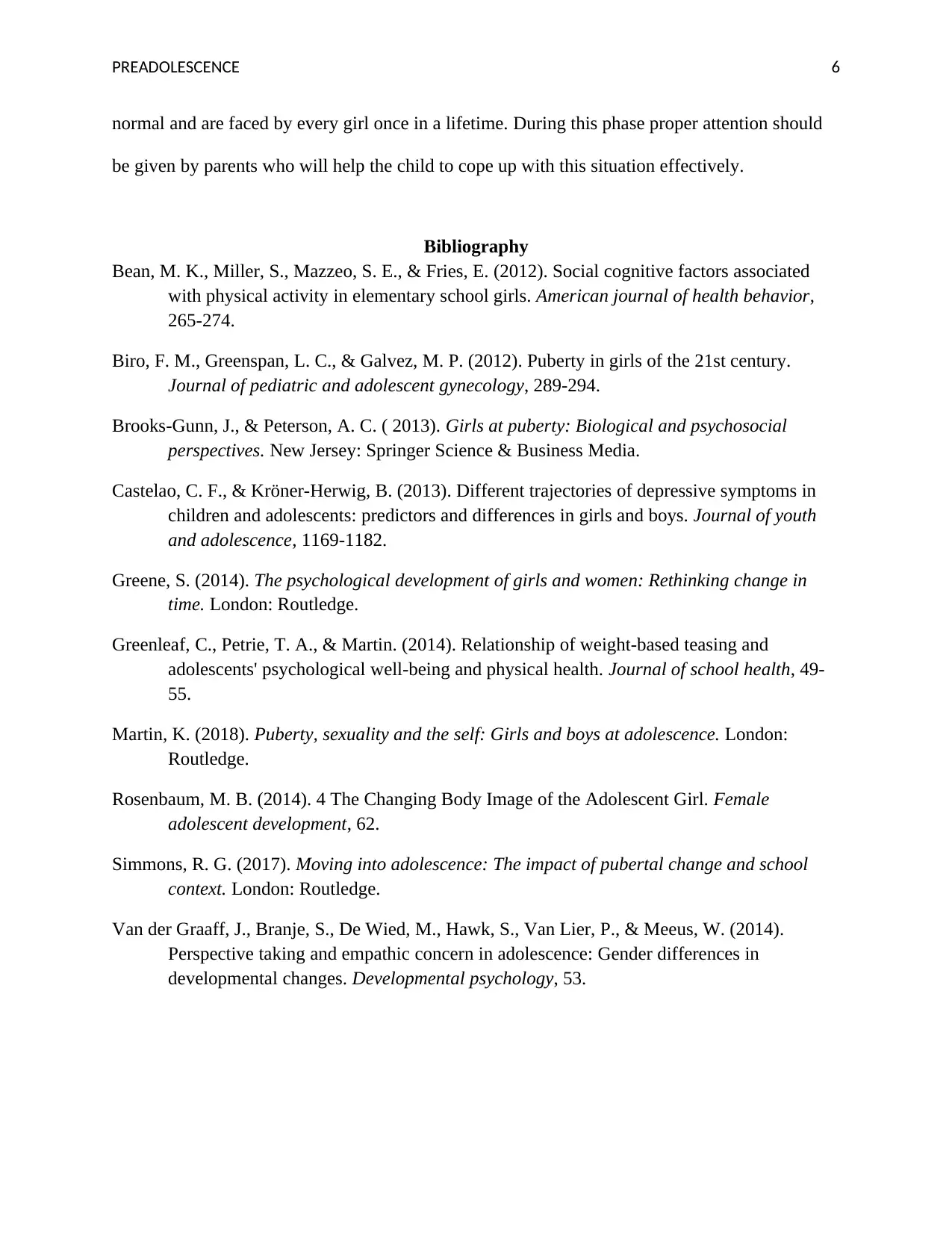
PREADOLESCENCE 6
normal and are faced by every girl once in a lifetime. During this phase proper attention should
be given by parents who will help the child to cope up with this situation effectively.
Bibliography
Bean, M. K., Miller, S., Mazzeo, S. E., & Fries, E. (2012). Social cognitive factors associated
with physical activity in elementary school girls. American journal of health behavior,
265-274.
Biro, F. M., Greenspan, L. C., & Galvez, M. P. (2012). Puberty in girls of the 21st century.
Journal of pediatric and adolescent gynecology, 289-294.
Brooks-Gunn, J., & Peterson, A. C. ( 2013). Girls at puberty: Biological and psychosocial
perspectives. New Jersey: Springer Science & Business Media.
Castelao, C. F., & Kröner-Herwig, B. (2013). Different trajectories of depressive symptoms in
children and adolescents: predictors and differences in girls and boys. Journal of youth
and adolescence, 1169-1182.
Greene, S. (2014). The psychological development of girls and women: Rethinking change in
time. London: Routledge.
Greenleaf, C., Petrie, T. A., & Martin. (2014). Relationship of weight‐based teasing and
adolescents' psychological well‐being and physical health. Journal of school health, 49-
55.
Martin, K. (2018). Puberty, sexuality and the self: Girls and boys at adolescence. London:
Routledge.
Rosenbaum, M. B. (2014). 4 The Changing Body Image of the Adolescent Girl. Female
adolescent development, 62.
Simmons, R. G. (2017). Moving into adolescence: The impact of pubertal change and school
context. London: Routledge.
Van der Graaff, J., Branje, S., De Wied, M., Hawk, S., Van Lier, P., & Meeus, W. (2014).
Perspective taking and empathic concern in adolescence: Gender differences in
developmental changes. Developmental psychology, 53.
normal and are faced by every girl once in a lifetime. During this phase proper attention should
be given by parents who will help the child to cope up with this situation effectively.
Bibliography
Bean, M. K., Miller, S., Mazzeo, S. E., & Fries, E. (2012). Social cognitive factors associated
with physical activity in elementary school girls. American journal of health behavior,
265-274.
Biro, F. M., Greenspan, L. C., & Galvez, M. P. (2012). Puberty in girls of the 21st century.
Journal of pediatric and adolescent gynecology, 289-294.
Brooks-Gunn, J., & Peterson, A. C. ( 2013). Girls at puberty: Biological and psychosocial
perspectives. New Jersey: Springer Science & Business Media.
Castelao, C. F., & Kröner-Herwig, B. (2013). Different trajectories of depressive symptoms in
children and adolescents: predictors and differences in girls and boys. Journal of youth
and adolescence, 1169-1182.
Greene, S. (2014). The psychological development of girls and women: Rethinking change in
time. London: Routledge.
Greenleaf, C., Petrie, T. A., & Martin. (2014). Relationship of weight‐based teasing and
adolescents' psychological well‐being and physical health. Journal of school health, 49-
55.
Martin, K. (2018). Puberty, sexuality and the self: Girls and boys at adolescence. London:
Routledge.
Rosenbaum, M. B. (2014). 4 The Changing Body Image of the Adolescent Girl. Female
adolescent development, 62.
Simmons, R. G. (2017). Moving into adolescence: The impact of pubertal change and school
context. London: Routledge.
Van der Graaff, J., Branje, S., De Wied, M., Hawk, S., Van Lier, P., & Meeus, W. (2014).
Perspective taking and empathic concern in adolescence: Gender differences in
developmental changes. Developmental psychology, 53.
Paraphrase This Document
Need a fresh take? Get an instant paraphrase of this document with our AI Paraphraser

PREADOLESCENCE 7
1 out of 8
Related Documents
Your All-in-One AI-Powered Toolkit for Academic Success.
+13062052269
info@desklib.com
Available 24*7 on WhatsApp / Email
![[object Object]](/_next/static/media/star-bottom.7253800d.svg)
Unlock your academic potential
Copyright © 2020–2025 A2Z Services. All Rights Reserved. Developed and managed by ZUCOL.





